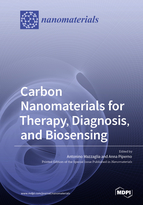Carbon Nanomaterials for Therapy, Diagnosis, and Biosensing
A special issue of Nanomaterials (ISSN 2079-4991). This special issue belongs to the section "Biology and Medicines".
Deadline for manuscript submissions: closed (31 July 2020) | Viewed by 34104
Special Issue Editors
Interests: cyclodextrins; self-assembly; nanodelivery; phototherapeutics; hybrids nanobiomaterials; carbon nanomaterials; nanomedicine; regenerative medicine
Special Issues, Collections and Topics in MDPI journals
Interests: carbon nanomaterials and biopolymers for applications in drug delivery, regenerative medicine, and biosensing; multifunctional graphene platforms with stimuli-responsive probes; nanomedicine; drug delivery; liquid biopsy
Special Issue Information
Dear Colleagues,
In the landscape of the design of carbon nanomaterials, the fine-tuning of their functionalities and physicochemical properties has increased their potential for therapeutic, diagnostic, and biosensing applications. In this issue, nanoplatforms originating from the synergistic combination of carbon based nanomaterials (i.e., nanotubes, graphene, graphene oxide, carbon quantum dots, fullerene, nanodiamond, etc.) with various functional molecules, such as drugs, natural compounds, biomolecules, polymers, metal nanoparticles, and macrocycles, and with a relevant perspective on drug delivery, multitargeted therapy, theranostics, as well as scaffolds in tissue engineering and biosensing, will be highly considered for publication, be they in the form of articles or mini reviews.
In particular, this issue seeks works that offer novel insight into the following subjects: i) Synthetic approaches (covalent and/or not covalent strategies) to improve therapeutic performances of carbon nanomaterials as drug carriers, including stimuli-responsive properties and as gene vectors; ii) design of carbon nanomaterials for diagnosis and theranostics, highlighting the physicochemical characterization and their correlation with the biological properties; iii) scaffolds based on carbon nanomaterials for regenerative medicine and tissue engineering;iv) novel carbon nanomaterial platforms as biosensors or “old” carbon nanomaterials with novel biosensing properties.
Prof. Dr. Antonino Mazzaglia
Prof. Dr. Anna Piperno
Guest Editors
Manuscript Submission Information
Manuscripts should be submitted online at www.mdpi.com by registering and logging in to this website. Once you are registered, click here to go to the submission form. Manuscripts can be submitted until the deadline. All submissions that pass pre-check are peer-reviewed. Accepted papers will be published continuously in the journal (as soon as accepted) and will be listed together on the special issue website. Research articles, review articles as well as short communications are invited. For planned papers, a title and short abstract (about 100 words) can be sent to the Editorial Office for announcement on this website.
Submitted manuscripts should not have been published previously, nor be under consideration for publication elsewhere (except conference proceedings papers). All manuscripts are thoroughly refereed through a single-blind peer-review process. A guide for authors and other relevant information for submission of manuscripts is available on the Instructions for Authors page. Nanomaterials is an international peer-reviewed open access semimonthly journal published by MDPI.
Please visit the Instructions for Authors page before submitting a manuscript. The Article Processing Charge (APC) for publication in this open access journal is 2900 CHF (Swiss Francs). Submitted papers should be well formatted and use good English. Authors may use MDPI's English editing service prior to publication or during author revisions.
Keywords
- carbon nanomaterial
- drug delivery
- imaging
- theranostic
- biosensing
- carbon nanomaterial toxicity
- signaling
- liquid biopsy
- carbon nanomaterial cellular uptake
- carbon nanomaterial/cell interactions








